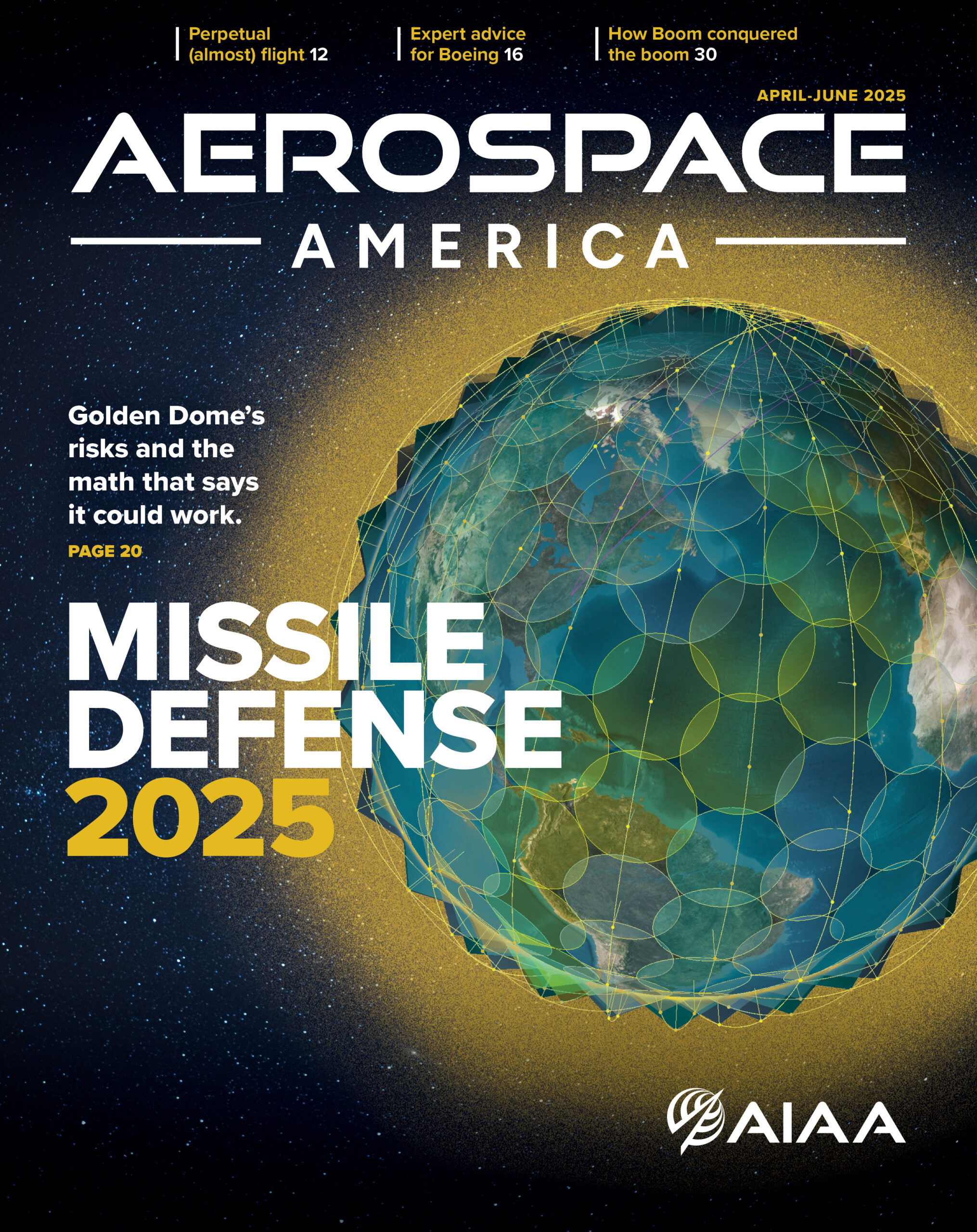Stay Up to Date
Submit your email address to receive the latest industry and Aerospace America news.
Ella Atkins, head of Virginia Tech’s Kevin T. Crofton Department of Aerospace and Ocean Engineering
Ella Atkins has been researching and publishing papers about autonomy in aerospace for decades, but her work is now in higher demand as innovators in the developing electric air taxi industry contemplate increasingly automated flight — perhaps even without pilots on board. I met with Atkins in January at AIAA’s SciTech Forum in Orlando, Florida, to discuss the history of automation in transportation, the technical challenges behind self-driving cars versus automated aircraft, and the challenge regulators face in certifying aircraft software that must continue to learn with each flight.
Q: How did automated transportation begin?
A: When you fly through Atlanta, you take a train between terminals. There’s no person in that train driving it. Instead, there are pre-recorded messages; there are sensors that tell the train where it is; sensors on the doors that open and shut them and detect people. Sometimes the trains go down when they’re fixing things, but they’re pretty reliable. I didn’t even notice in Orlando [International Airport] whether there was a train driver or not, because I felt very comfortable. And if you look at why a train in, say, an airport like Orlando or Atlanta was first to be automated, it’s because of the controlled environment. The train is on a track of some sort, and you don’t have to steer it. You just have to go slow enough that it’s not going to derail, and the tunnels are controlled, so you don’t expect to need to detect people who might get in front of the train.
Q: In aviation, autopilot has been evolving and getting more sophisticated over the years, right?
A: The first autopilots just maintained altitude and heading, and the instruments for that were fairly straightforward. The altitude was pressure based, and the heading was compass based, and you did not need sophisticated computers or software to dial in on a heading or follow the pressure sensor to a particular altitude. You might be off by a little bit, but if you’re flying at several thousand feet, the amount that you would be off would be within margins for being safe. And back then, there were not so many airplanes. Then, more instruments were created because pilots were getting lost. We had some avionics-based autopilots that basically would just maintain altitude and heading. And then once computers got to the point where they were small, lightweight, low-power systems that could fit in an aircraft, that’s when we transitioned to what we know as the flight management system.
And then we got all of these options with a small computer screen that the pilot could enter data on, and that was more sophisticated than just an altitude and a heading. And then we got GPS, and things kind of snowballed from there. Suddenly, with all of the sensors that we traditionally have had on board to measure inertial conditions and air speed and side slip and angle of attack, we’re able to now have a really reliable estimate of state for the aircraft. Along with emerging feedback controllers that were quite good, and guidance algorithms, we ended up with true autopilot, as long as the data is available.
Probably the biggest advance was in fuel management. The cockpit crew in modern aircraft went down in the 1980s from three to two people when the flight engineer was not needed anymore.
Q: They had an extra person on board, an engineer, just to monitor fuel management?
A: Yes, the flight engineer looked at engine temperatures and condition and projected forward whether there was enough fuel to land. In the 747, there were two people facing forward, and then there was one person facing sideways, because that flight engineer did not need to look out the windshield; they were looking at a panel of instruments and had a series of knobs that they turned. So they would be responsible for switching between fuel tanks, monitoring everything with the engine, pressures, temperatures, everything that allows them to determine if they thought an engine was going to have a problem.
This was a set of functions that software excels at, because it’s all math. That’s all monitored by software now. Every engine has a FADEC, a full authority digital engine controller. All of the work the flight engineer used to do is now done by this computer inside the engine. And that is a big step forward for jet engines, because the FADEC can now monitor hundreds, if not thousands, of sensor measurements. There are measurements of vibration, because an early indication that your jet engine might be having problems is if you have vibration. If you have some kind of vibration happening, it will actually adjust the parameters of fuel flow and turbine speeds to try to manage it without shutting the engine down.
This is important, because that is the last time we actually took a person out of the airplane and replaced that person with software. The computer was doing what it does better than people, and nobody questions that. It’s almost unheard of now that a modern jet aircraft has run out of fuel. Even so, airlines are in no hurry to downsize the crew any further.
Q: I’m often hearing the term “operator” today instead of “pilot” in some situations. What do you make of this shift in how we describe the person controlling an aircraft?
A: I’m wondering if this change from “pilot” to “operator” actually has any substance, or whether it’s actually something that allows those who feel they are real pilots to ridicule those who are operators. I do know that a pilot of a commercial aircraft often does the same thing that an uncrewed aerial system operator on the ground does. They monitor screens and software, and they push buttons and turn sticks that go through the computer fly-by-wire. The only difference is that the person on the ground doesn’t have a shared fate.
Even with high levels of automation, pilots would tell you it’s the most dangerous and high-workload time that the most critical decisions are made, and they need all of their understanding as both a pilot and somebody who’s paid attention to the control software. Pilots actually need to understand what’s going on in the software well enough to determine whether it’s working. If they don’t, we call that mode confusion. The reason mode confusion happens in many cases is not that the pilot is a loser but that they didn’t actually have an understanding of the different logic functions that were going on in the aircraft.
A reason that pilots have to take over often is that we have made the choice to have a continuation of voice-based communication that does not go through the computers. The flight management system was never designed to push all of the buttons that needed to be pushed.
Q: Then we have the concept of autopilot, or self-driving cars. How did that evolve and when?
A: Car companies became aware that having some automation was helpful as far back as the 1970s. For example, airbags automatically deploy, and antilock brakes automatically stop you when you begin to slide. Even antilock brakes were considered controversial in the 1980s.
Other examples of automation being introduced were traction control, cruise control and lane steering, where there were systems that would detect where the lines were, where the edge of the road was, and alert you. So, you don’t wake up one morning and have self-driving cars; you build it from the ground up. All of these things happened in the traditional auto world before automobile autopilot existed. They’re all building blocks. So, there’s no secret sauce about self-driving cars. What was new was integrating them all together with a computer that called itself an autopilot.
In cars, we have levels of autonomy. Level 0 is the driver doing everything. Level 5 is where you don’t need lane markers or other signage that a car camera can easily reference; the car will drive itself with no intervention. The first autopilot in cars offered commercially was sold as Level 2, which means that it can hold itself on the road and maintain speed, but the driver always needs to be vigilant to take over.
The problem is the public doesn’t really know the different levels of autonomy. So even though they said this is a Level 2 product, the customer said, “The autopilot can drive my car, and all I have to do is hold my left hand on the steering wheel.” And then there were people that did things like hanging a weight from the steering wheel and getting in the back seat to play games or take a nap. So the customers did not use it appropriately.
Q: Moving on, everything that’s been learned so far is now being contemplated for more fully autonomous aircraft, correct?
A: Yes. Flying an airplane, although it’s scarier and three dimensional, is actually easier than driving a car for several reasons. One is there’s no pedestrians, bicycles, animals and so forth.
We know where the planes are now, very accurately. That means that the problem of each airplane knowing where the others are has been solved. That is a huge deal that has not yet happened for cars; the automation problem for aircraft is actually easier. The thing that is more complicated, in a nutshell, is contingency management, which is where I’ve focused most of my career. And the reason that’s harder is that with a car, your goal is to stop and pull off to the side of the road. If you can’t make it to the side of the road or to an exit ramp, you stop in the road. However, if you’re up in the air, maybe at several thousand feet, there’s an entire sequence of things that you have to do to be safe. If you just stop, you fall out of the air. You have to figure out how to get down on the ground safely, and that really is tricky.
Once you get into low-altitude environments, the problem changes from clear airspace to “I need to actually avoid stuff.” And whether it’s mountains or power lines or cell towers or buildings, maps today are not perfect, and we actually need to pay attention. We have a very rigorous process for deciding whether houses and towers and so forth can be built adjacent to major airports, so you don’t have an unknown cell tower that pops up right before you’re going to land right at Orlando. But if you’re going to land at a random vertiport in an urban area, it’s possible that something could have popped up, and it’s not on the map. For example, construction cranes are not really ever mapped on aviation charts, and they’re pretty tall. So, you actually have to be able to detect things like that. The path forward — which I think NASA is interested in, and I know that I’m interested in — is how to mine other data types. For example, construction permits in cities, which could tell you there might be a construction crane right over there.
Q: Currently, FAA hasn’t embraced the use of artificial intelligence in flight, but is that coming soon, and when do you think AI might be more widely embraced in aviation?
A: When it comes to FAA, they’ve made a distinction as to whether artificial intelligence or machine learning is used strictly before certification or whether it’s also allowed to continue learning and evolving after certification. Right now, there are a couple of systems for collision avoidance, for example, that were based on something called the Markov decision process, which uses something called reinforcement learning, a machine learning technique. That particular collision avoidance system, because it was developed by machine learning and AI, FAA regulators decided that they would certify a frozen version of it. Frozen means that it’s finished learning.
Can you imagine if we froze the human brain and said, “You’re finished learning”? You just can’t freeze systems that have been optimized around using AI or machine learning. You have to let them learn, just like a person has to be able to learn on the job. It’s not AI or machine learning if you froze it; it’s just a bunch of if-then statements with some math. Anything you freeze like that is no longer AI.
Q: In China, EHang is already selling electric vertical takeoff and landing aircraft that have no pilot on board, so they are totally automated. What do you make of that?
A: In China, it’s a different environment ever since the commercial drone companies emerged and DJI captured a lion’s share of global markets. They were like, “Hey, there’s a business opportunity here.” The public and the government have been aligned to see how far they can take this. But here, the public and the government have tried to stop it because there’s fear.
China is doing the same things that we know how to do. They just don’t have the same constraints on releasing them into a product. There’s no reason to believe that they have a secret sauce that goes beyond what we know how to do. We just don’t have approval to do it, and our companies are skittish, and our passengers are afraid.
About paul brinkmann
Paul covers advanced air mobility, space launches and more for our website and the quarterly magazine. Paul joined us in 2022 and is based near Kennedy Space Center in Florida. He previously covered aerospace for United Press International and the Orlando Sentinel.
Related Posts
Stay Up to Date
Submit your email address to receive the latest industry and Aerospace America news.




